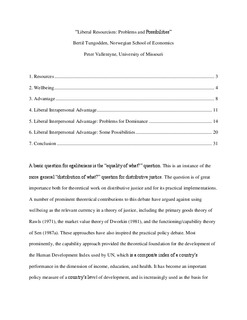| dc.description | -This is the author's version of the article: "Liberal Resourcism: Problems and Possibilities", Journal of Social Philosophy, Special Issue: Egalitarian Justice, Volume 44, Issue 4, pages 348–369, Winter 2013. | nb_NO |
| dc.description.abstract | A basic question for egalitarians is the “equality of what?” question. This is an instance of the more general “distribution of what?” question for distributive
justice. The question is of great importance both for theoretical work on distributive justice and for its practical implementations. A number of prominent theoretical
contributions to this debate have argued against using well-being as the relevant currency in a theory of justice, including the primary goods theory of Rawls (1971), the market value theory of Dworkin (1981), and the functioning or capability theory of Sen (1987a). These approaches have also inspired the practical policy debate. Most prominently, the capability approach provided the theoretical foundation for the development of the Human Development Index used by the United Nations, which is a composite index of a country’s performance in the
dimension of income, education, and health. It has become an important policy measure of a country’s level of development and is increasingly used as the basis
for allocating aid to developing countries. A common feature of these alternative approaches is that they introduce a multidimensional currency for distributive justice (e.g., a list of primary goods, market goods, or capabilities). This raises the fundamental problem of how to
construct an overall measure of advantage, where “advantage” is the generic term for the currency of distributive justice. It is commonly argued (e.g., Sen 1987b,29–30) that, even though this may be a challenging task, it is straightforward when the bundle of one individual dominates the bundle of another person (e.g., more in each dimension). In these cases, one may argue that everyone, independently of their conception of the good life, agrees that the dominating bundle is more
valuable, and thus that the person holding this bundle has greater advantage. We show, however, that even the dominance approach leads to incoherence if the theory is sensitive to an individual’s own conception of the good life in intrapersonal comparisons.
We shall focus on liberal resourcist theories of advantage, where we take resourcism to be the view that whether one person gets at least as much advantage from her resource bundle as a second person gets from his resource bundle does
not depend on any interpersonal comparisons of well-being. Throughout, we place no restrictions on what may count as a resource (e.g., primary goods, market goods, capabilities, or other items). Resourcism is simply committed to assessing
the advantage value of a resource bundle without any appeal to interpersonal comparisons of well-being. We take liberal resourcism to further hold that (1) intrapersonal rankings of the advantage of resource bundles must agree with
(defer to) the person’s intrapersonal well-being ranking, and (2) interpersonal rankings of advantage of resource bundles must be neutral among different individual conceptions of the good life. We argue that the fundamental problem of the above dominance approach is that it implies no sensitivity to the individual conceptions of the good life in interpersonal comparisons of advantage, which is necessary to capture fully the liberal ambition of neutrality. We introduce a condition that formalizes this
requirement and show that it makes possible a coherent liberal resourcist account of advantage. The resulting form of liberal resourcism, however, avoids incoherence
only by being silent about the assessment of advantage for a broad range of resource bundles. We leave it as a challenge to liberal resourcists to determine whether this theory of advantage can be made more robust. In the next sections, we clarify further the notions of resource, well-being, and advantage. We then introduce the fundamental problem of liberal resourcism and discuss possible solutions. | nb_NO |
